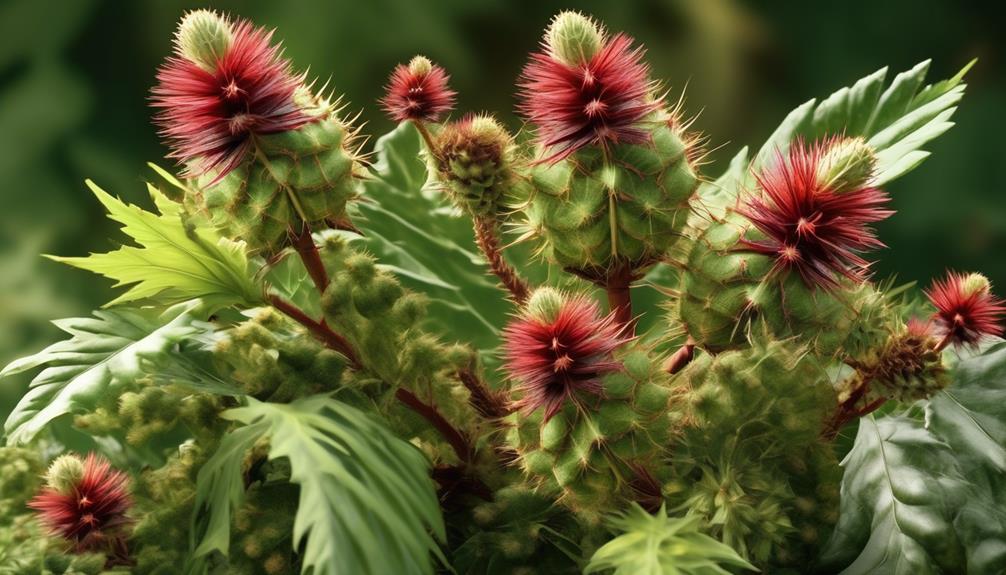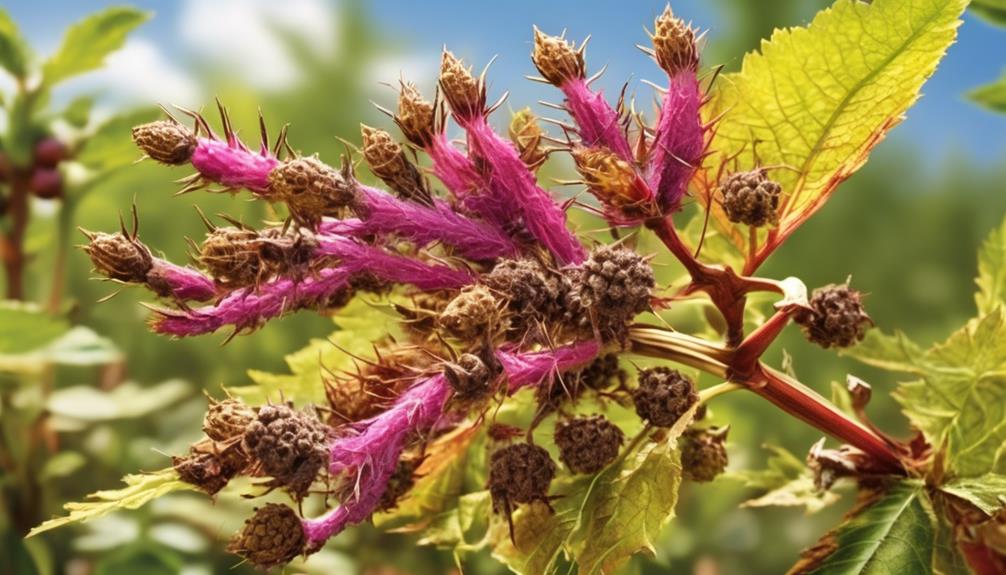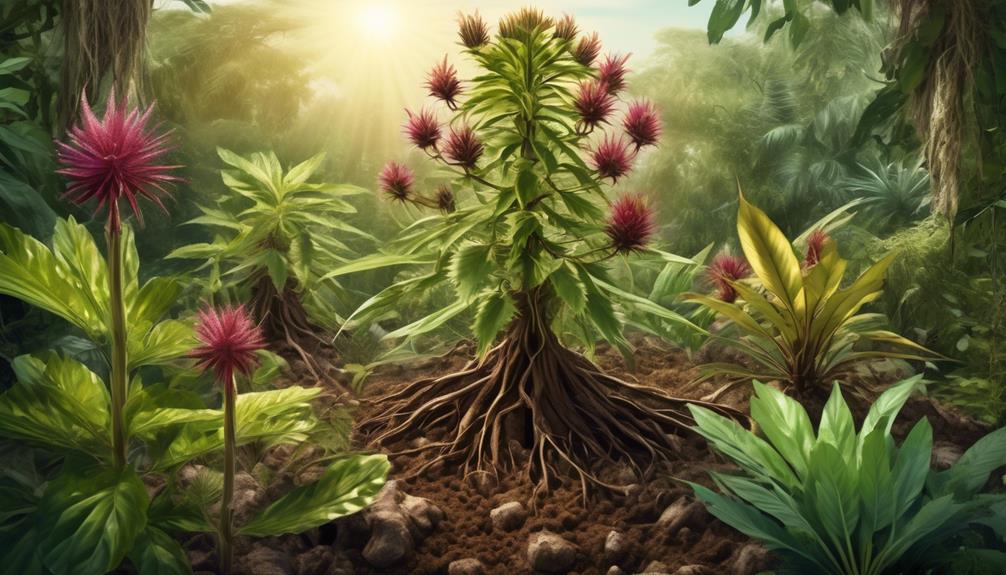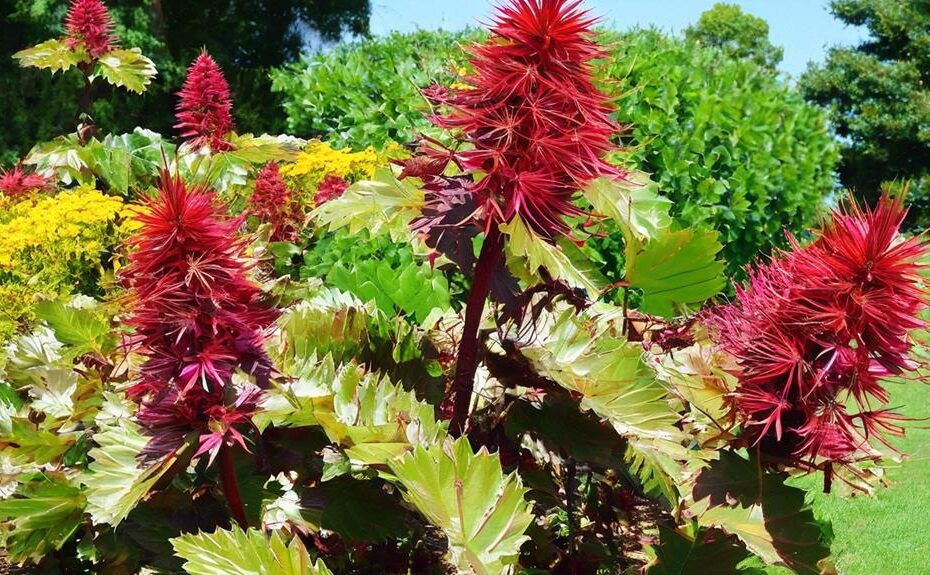Are Castor Oil Plants Perennial?
Castor oil plants, also known as Ricinus communis, have long fascinated gardeners and botanists alike. Their lush foliage and distinctive seed pods make them a popular choice for ornamental gardens.
There is an ongoing debate about the perennial nature of castor oil plants. While some claim they are indeed perennial, others argue they are classified as annuals.
In this discussion, we will explore the growth characteristics, environmental requirements, and reproduction of castor oil plants to shed light on the intriguing question of whether they are perennial or annual.
By examining factors that influence their perennial nature and dispelling common misconceptions, we hope to unravel the mystery surrounding the longevity of these fascinating plants.
Stay tuned to discover the truth about the perennial status of castor oil plants.
Key Takeaways
- Castor oil plants have a fast growth rate, reaching up to 10 feet tall in a single growing season.
- They thrive in warm climates with temperatures ranging from 20 to 30 degrees Celsius and require full sun exposure.
- They are relatively drought-tolerant, but consistent moisture is necessary for optimal growth.
- Factors influencing perenniality include soil composition, nutrient content, and presence of soil-borne diseases and pests.
Growth Characteristics of Castor Oil Plants

The growth characteristics of castor oil plants are a subject of interest due to their unique perennial nature and distinctive physiological traits. Castor oil plants, scientifically known as Ricinus communis, are known for their fast growth rate and vigorous development. Under optimal conditions, these plants can grow up to 10 feet tall within a single growing season. The growth rate of castor oil plants is influenced by various factors, including temperature, soil fertility, and water availability. In general, warmer temperatures and adequate soil moisture promote faster growth.
Pruning techniques can also play a role in managing the growth of castor oil plants. Pruning can be used to control the height and shape of the plants, particularly in garden or landscape settings. Regular pruning can help maintain a more compact and bushy form, preventing the plants from becoming too leggy or top-heavy. It is recommended to prune the plants in early spring, before they start their active growth. This allows for better branching and overall plant structure. When pruning, it is important to use clean and sharp tools to minimize the risk of disease transmission.
Environmental Requirements for Castor Oil Plants
Castor oil plants require specific environmental conditions in order to thrive and exhibit their unique growth characteristics. Here are four key environmental requirements for castor oil plants:
- Climate adaptation: Castor oil plants are native to tropical and subtropical regions, and they thrive in warm climates with temperatures ranging from 20 to 30 degrees Celsius (68 to 86 degrees Fahrenheit). They can tolerate some fluctuations in temperature, but extreme cold or hot temperatures can adversely affect their growth and development.
- Sunlight: Castor oil plants require full sun exposure to thrive. They need at least six to eight hours of direct sunlight daily. Insufficient sunlight can lead to stunted growth and reduced oil production.
- Moisture: Castor oil plants are relatively drought-tolerant, but they still require consistent moisture for optimal growth. They prefer well-drained soils that retain some moisture. Adequate irrigation is necessary during dry periods to prevent water stress and ensure healthy growth.
- Soil fertility: Castor oil plants prefer fertile, loamy soils with good drainage. They can tolerate a wide range of soil pH levels, but slightly acidic to neutral soils (pH 6.0-7.5) are ideal. Adding organic matter, such as compost or well-rotted manure, can improve soil fertility and enhance plant growth.
Reproduction and Life Cycle of Castor Oil Plants

The reproduction and life cycle of castor oil plants involve several stages.
It begins with planting castor oil seeds, which germinate and develop into seedlings.
These seedlings grow into mature plants that go through various growth stages until they reach the point of harvest, where the castor oil is extracted from the seeds.
Understanding the reproductive and life cycle processes is crucial for successful cultivation and utilization of castor oil plants.
Planting Castor Oil Seeds
Planting castor oil seeds is an essential step in the reproduction and life cycle of these perennial plants. To ensure successful germination and growth, it is important to follow appropriate planting techniques and meet specific soil requirements.
Here are four key factors to consider when planting castor oil seeds:
- Soil type: Castor oil plants thrive in well-drained soils with a pH range of 5.5 to 6.5. Sandy loam or loamy soils are ideal for providing adequate drainage while retaining moisture.
- Soil preparation: Prior to planting, the soil should be loosened and free of weeds, rocks, or debris. Adding organic matter, such as compost or well-rotted manure, can improve soil fertility and structure.
- Planting depth: Castor oil seeds should be sown at a depth of 1 to 1.5 inches. Planting too shallow may result in poor germination, while planting too deep can hinder emergence.
- Spacing: Adequate spacing between plants is crucial for proper air circulation and nutrient uptake. Castor oil plants should be spaced around 3 feet apart to allow for their vigorous growth and development.
Growth Stages of Castor Plants
During the growth stages of castor plants, they undergo various reproductive processes and life cycle events. Castor plants, also known as Ricinus communis, are dicotyledonous plants that exhibit an annual life cycle. The growth stages of castor plants can be divided into four main phases: germination, vegetative growth, flowering, and seed production.
The first stage, germination, occurs when the castor seeds are planted in suitable soil and provided with adequate moisture and warmth. The seeds sprout, and the root and shoot emerge from the seed coat. This is followed by the vegetative growth stage, where the plant develops leaves, stems, and branches. During this phase, the plant focuses on photosynthesis and building its biomass.
The flowering stage is the most critical phase in the life cycle of castor plants. It is during this stage that the plant produces inflorescences, consisting of both male and female flowers. The flowers are small and inconspicuous, with the male flowers producing pollen and the female flowers containing the ovary.
After successful pollination, the female flowers develop into seed capsules. These capsules mature over time and eventually burst open, releasing the seeds. The seeds, which are rich in oil, are then harvested for various purposes, including the production of castor oil.
Cultivation techniques play a crucial role in the growth stages of castor plants. Proper soil preparation, irrigation, and fertilization are essential for optimal growth and yield. Additionally, controlling pests and diseases, such as whiteflies and fungal infections, is crucial for plant health and productivity.
Harvesting Castor Oil
Throughout the reproductive stages and life cycle of castor plants, the culmination of their growth and development leads to the vital process of harvesting castor oil. Harvesting castor oil involves specific techniques to ensure the extraction of the oil from the plant's seeds.
Here are four important aspects of harvesting castor oil:
- Timing: The optimal time for harvesting castor oil is when the seed pods have turned brown and start to split open. This indicates that the seeds are mature and ready for harvesting.
- Seed extraction: Once the seed pods have split open, the seeds can be collected by hand or through mechanical means. It is crucial to handle the seeds with care as they are toxic and can cause skin irritation.
- Oil extraction: After the seeds have been collected, they are typically dried and then crushed to release the oil. This can be done through mechanical pressing or solvent extraction methods.
- Medicinal uses: Castor oil has been used for centuries for its medicinal properties. It is known for its laxative effects and is also used in various skincare and haircare products due to its moisturizing and nourishing properties.
Factors That Influence the Perennial Nature of Castor Oil Plants

The perennial nature of Castor Oil plants is influenced by various factors, which contribute to their long-lasting growth and sustainability. One of the key factors affecting the perenniality of Castor Oil plants is the composition of the soil in which they are grown.
The soil composition plays a crucial role in the overall health and longevity of Castor Oil plants. These plants thrive in well-drained soil that is rich in organic matter. Adequate drainage is necessary to prevent waterlogging, which can lead to root rot and other diseases. Furthermore, Castor Oil plants prefer soil with a pH level between 6 and 7, as extreme acidity or alkalinity can hinder their growth.
In addition to drainage and pH levels, the soil's nutrient content also affects the perennial nature of Castor Oil plants. These plants require a balanced supply of nutrients, including nitrogen, phosphorus, and potassium, for optimal growth. Insufficient nutrient levels can result in stunted growth and decreased perenniality.
Moreover, the presence of certain soil-borne diseases and pests can also influence the perenniality of Castor Oil plants. These plants are susceptible to fungal infections, such as root rot and wilt diseases, as well as insect pests like aphids and spider mites. Regular monitoring and appropriate pest management practices are necessary to mitigate the impact of these factors on the plants' longevity.
Caring for Castor Oil Plants in Different Climates
When caring for castor oil plants in different climates, there are several important considerations to keep in mind.
Firstly, the climate plays a crucial role in determining the success of these plants, as they prefer warm and tropical environments.
Secondly, watering requirements should be adjusted according to the climate, ensuring that the plants receive adequate moisture without becoming waterlogged.
Lastly, castor oil plants have a moderate tolerance to temperature fluctuations, but extreme cold or heat can negatively impact their growth and survival.
Climate Considerations
Considering the diverse range of climates that castor oil plants can thrive in, it is essential to understand the specific care requirements for each environment. Climate change can significantly impact the growth and development of castor oil plants, making it crucial to adapt their care accordingly.
Here are four important considerations when caring for castor oil plants in different climates:
- Temperature: Castor oil plants prefer warm climates with temperatures ranging from 75 to 85 degrees Fahrenheit. They can tolerate a slight drop in temperature but are susceptible to frost damage.
- Humidity: Castor oil plants thrive in areas with high humidity levels. They require humid conditions to prevent leaf scorching and maintain their overall health.
- Sunlight: These plants require full sun exposure for optimal growth. They need at least six to eight hours of direct sunlight daily.
- Soil fertility: Castor oil plants prefer well-draining soils with a pH level between 5.5 and 7.5. Rich, loamy soils with good fertility and organic matter content are ideal for their growth.
Watering Requirements
Given the diverse range of climates that castor oil plants can thrive in, understanding their watering requirements becomes crucial for their successful care in different environmental conditions.
Castor oil plants have a high drought tolerance, making them suitable for cultivation in arid regions. However, during the initial stages of growth, they require consistent watering to establish strong root systems. Once established, these plants can withstand periods of drought without experiencing significant damage.
When it comes to soil requirements, castor oil plants prefer well-draining soil with a pH range of 5.5 to 6.5. This allows for proper nutrient absorption and prevents waterlogging, which can lead to root rot.
Regular watering, allowing the soil to dry out slightly between waterings, is recommended to maintain optimal growth and health for castor oil plants.
Temperature Tolerance
Castor oil plants demonstrate impressive temperature tolerance, enabling successful cultivation in a wide range of climates. Understanding their temperature requirements is crucial for ensuring optimal growth and survival.
Here are four key points to consider regarding temperature tolerance in castor oil plants:
- Temperature Range: Castor oil plants thrive in warm to hot climates, with optimal growth occurring between 77°F (25°C) and 95°F (35°C). They can tolerate temperatures as low as 50°F (10°C) but may suffer damage or slow growth at temperatures below this range.
- Cold Tolerance: While castor oil plants prefer warmth, they can withstand brief periods of cold temperatures, particularly if they are mature and established. However, prolonged exposure to frost or freezing temperatures can be detrimental, leading to leaf damage or plant death.
- Temperature Fluctuations: Castor oil plants can tolerate moderate temperature fluctuations but prefer stable conditions. Rapid and extreme temperature changes can stress the plants and affect their growth and development.
- Protective Measures: In regions with colder climates, it is advisable to grow castor oil plants in containers or as annuals. This allows for easier protection during colder months by moving them indoors or providing frost covers.
Common Misconceptions About Castor Oil Plant Longevity
One common misconception regarding the longevity of the castor oil plant is often rooted in a lack of understanding of its true nature and growth habits. While some may believe that the castor oil plant is a perennial, it is actually an annual plant. This misconception may arise from the fact that the plant can reach impressive heights of up to 12 feet and has a robust and vigorous growth pattern.
The misconception about the castor oil plant's longevity can also be attributed to its ability to self-seed. Castor oil plants produce large seed pods that burst open, dispersing their seeds over a wide area. These seeds can remain dormant in the soil for extended periods and germinate when favorable conditions arise, giving the impression that the plant is perennial.
However, several factors contribute to the limited lifespan of the castor oil plant. Firstly, it is highly sensitive to frost and cannot survive in cold temperatures. Additionally, the plant exhausts its resources while producing seeds, leading to its eventual death.
It is crucial to understand these longevity factors in order to properly care for and manage castor oil plants.
Frequently Asked Questions
Can Castor Oil Plants Be Grown Indoors?
Growing castor oil plants hydroponically indoors offers several benefits. It allows for year-round cultivation, reduces the risk of pests and diseases, and provides control over environmental conditions. With proper care, castor oil plants can thrive and produce high-quality oil in indoor settings.
How Long Does It Take for a Castor Oil Plant to Reach Full Maturity?
The growth rate of castor oil plants varies depending on several factors, such as environmental conditions and cultivation practices. It typically takes around 1 to 2 years for a castor oil plant to reach full maturity.
Can Castor Oil Plants Survive in Cold Climates?
Winter care is crucial for castor oil plants in cold climates. To protect them from frost, provide a thick layer of mulch around the base and cover with a frost cloth. Opt for hardy varieties like 'Zanzibarensis' or 'Gibsonii' for better survival in cold regions.
What Are the Common Pests and Diseases That Affect Castor Oil Plants?
Common pests and diseases that affect castor oil plants include aphids, spider mites, whiteflies, powdery mildew, and root rot. Identification and prevention are crucial for effective management. Implementing proper cultural practices and using organic insecticides can help control infestations.
Are There Any Special Pruning Techniques Required for Maintaining Castor Oil Plants?
Pruning benefits and techniques are important for maintaining castor oil plants. Proper pruning can help promote plant health, control size and shape, and improve overall aesthetics. Regular pruning is recommended to remove dead or damaged branches and to encourage new growth.
Conclusion
In conclusion, castor oil plants are not perennial, but rather annual plants that complete their life cycle within a year. They require specific environmental conditions and careful cultivation to thrive. Despite common misconceptions about their longevity, castor oil plants do not persist year after year.
Understanding their growth characteristics, reproductive cycle, and environmental requirements is crucial for successfully caring for these plants in different climates. By adopting a scientific and objective approach, we can ensure the proper cultivation and management of castor oil plants.




